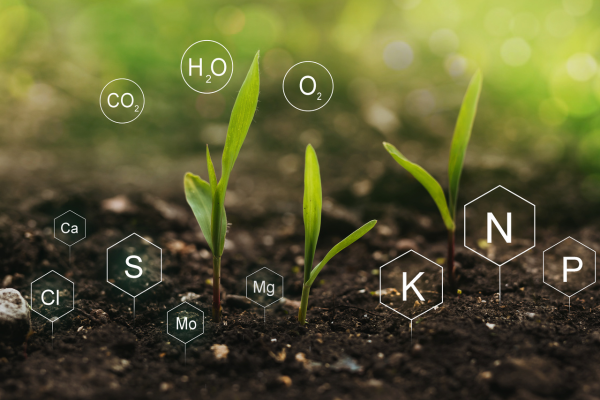
Plant Nutrients
October 05, 2023
Let’s review some of the key nutrients plants need to thrive:
Nitrogen – taken up as nitrate – NO3- (predominant) and ammonium – NH4+
- Nitrogen is needed for the formation of all living cells, a component of amino acids, proteins, enzymes, chlorophyll, DNA, RNA, and nucleic acids. It is also a component of ADP and ATP (energy transfer). In short, plants can not grow or develop without nitrogen. Therefore, a lack of nitrogen results in poor growth, development, and reproduction. Because of nitrogen’s function in chlorophyll, plants lacking nitrogen will be lighter green and lackluster in growth. Since nitrogen is mobile in the plant, older leaves are affected first and symptoms move up the plant.
Phosphorus – taken up as phosphate H2PO4– and HPO4-2
- Phosphorus is important in energy transfer in the plant as a part of ADP and ATP (as in adenosine triphosphate), and this energy transfer mechanism (ATP to ADP) is involved in photosynthesis and respiration. Phosphorus is a component in DNA and RNA, thus important in cell replication. So the plant needs phosphorus for cell division, early growth and root formation, and seed production. Phosphorus is required in all aspects of cell growth. Since phosphorus is needed for all aspects of plant growth, plants deficient in P will grow poorly, produce fewer tillers, exhibit stunting, delayed maturity, and reduced yield. Phosphorus-deficient plants are generally dark green. In corn, purpling may occur on the lower leaf margins. In soybeans and small grains, plants will be stunted, spindly, and have small leaflets or leaves and dark green foliage. In alfalfa, the symptoms are less well defined. Plants typically exhibit stunted growth, dark bluish-green leaves, poor root development, and short slender stems. Symptoms often appear on lower leaves first and are favored by cold, wet, or dry soils.
Potassium – (taken up as K+)
- Although plants need large amounts of K, it is not part of the organic compounds of the plant like N and P. Potassium is involved in the opening and closing of stomata (leaf pores). It is involved in the translocation of sugars, formation of starches, nitrogen metabolism, and as an enzyme catalyst. Potassium is also linked to increased disease and lodging resistance, carbohydrate production (seed filling), and winter hardiness in alfalfa.
- In general, plants deficient in potassium exhibit chlorotic leaves (older leaves first because it’s mobile) with scattered dark spots and weak stalks. In corn, you will see firing or scorching along the leaf margin (like the legs of the letter K, potassium firing moves around the edge of the leaf). The edges become ragged and the leaf dies, but the midrib remains green. Plants lodge late in the season, and ears may be small with poorly developed tips. In soybeans, firing will appear at the edges of the leaflets while basal portions remain green. The seed will be shriveled and not uniform. In small grains, plants will have weak stems and be prone to lodging. Leaves will lose color from tip to the base, and plants may look scorched. Potassium is the most common deficiency in alfalfa. Small white spots appear first at the margin of the lower leaflets. As symptoms progress, the areas between the spots turn yellow and die, and the spotting moves up the plant.
Sulfur – taken up as sulfate – SO42-
- Symptoms of sulfur deficiency are similar to those of nitrogen, (small spindly plants, poor growth, and delayed maturity), but because S is not mobile in the plant, young leaves are affected first. In small grains, the classic symptom of sulfur deficiency is bright yellow foliage. In corn, soybeans, and alfalfa, yellowing will be observed in new foliage rather than older leaves as seen with N deficiency. Soybeans deficient in sulfur will have thin, hard elongated stems. The availability of sulfur in soil depends on the rate of microbial release from organic matter. Plants grown on soils low in organic matter, excessively drained sandy soils, acidic soils, cold, wet soils, and eroded soils are likely to exhibit sulfur deficiency symptoms.
Zinc – taken up as zinc ion – Zn2+
- Zinc is only partially mobile in the plant so deficiency symptoms will appear on the younger and middle leaves. Interveinal chlorosis, yellowing, or bleaching are symptoms of zinc deficiency.
Iron – taken up as ferrous – Fe2+ (primarily) and ferric Fe3+
- Iron deficiency symptoms are common on high pH soils and in soybeans, at soil pHs above 7.0. General symptoms of Fe deficiency include interveinal chlorosis or yellow striping appearing first on the younger leaves since Fe is not translocated within the plant. Under severe Fe deficiencies, the entire plant can turn yellow to bleached white. Iron deficiency is rare in corn and alfalfa but common in soybeans.
Dr. John McNamara // Wilbur-Ellis Agronomist

